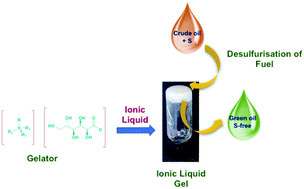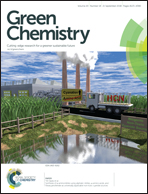“Sweet” ionic liquid gels: materials for sweetening of fuels†
Abstract
The search for new materials to be used in desulfurisation (sweetening) of fuels is one of the main topics of current research. In this paper, we explored the possibility of using supramolecular gels obtained from the gelation of ionic liquid binary mixtures. Indeed, some ionic liquids are generally known as efficient extraction phases for desulfurisation of fuels. In rare cases, one of their main drawbacks is their partial solubility in the fuel, leading to contamination. Then, their immobilisation due to the formation of a gelatinous network may be a challenge. Ionic liquid gels were obtained by mixing certain [NTf2]−-based ionic liquids (solvents) with the ones of gluconate-based ionic liquids (gelators). Our gelators are derived from renewable sugars, which possess the marked ability to form hydrogen bonds highly favouring gel formation. In this work, for the first time, ionic liquid gels were used to adsorb typical sulfur compounds omnipresent in fuels. Aromatic sulfur contaminants like thiophene, benzothiophene and dibenzothiophene were selected as model compounds. Our ionogels proved to be efficient adsorption phases, particularly in the removal of benzo- and dibenzothiophenes usually claimed to be refractory compounds for both extraction and oxidative desulfurisation processes. The adsorption efficiency was barely affected by volume, but significantly depended on the fuel concentration.



 Please wait while we load your content...
Please wait while we load your content...